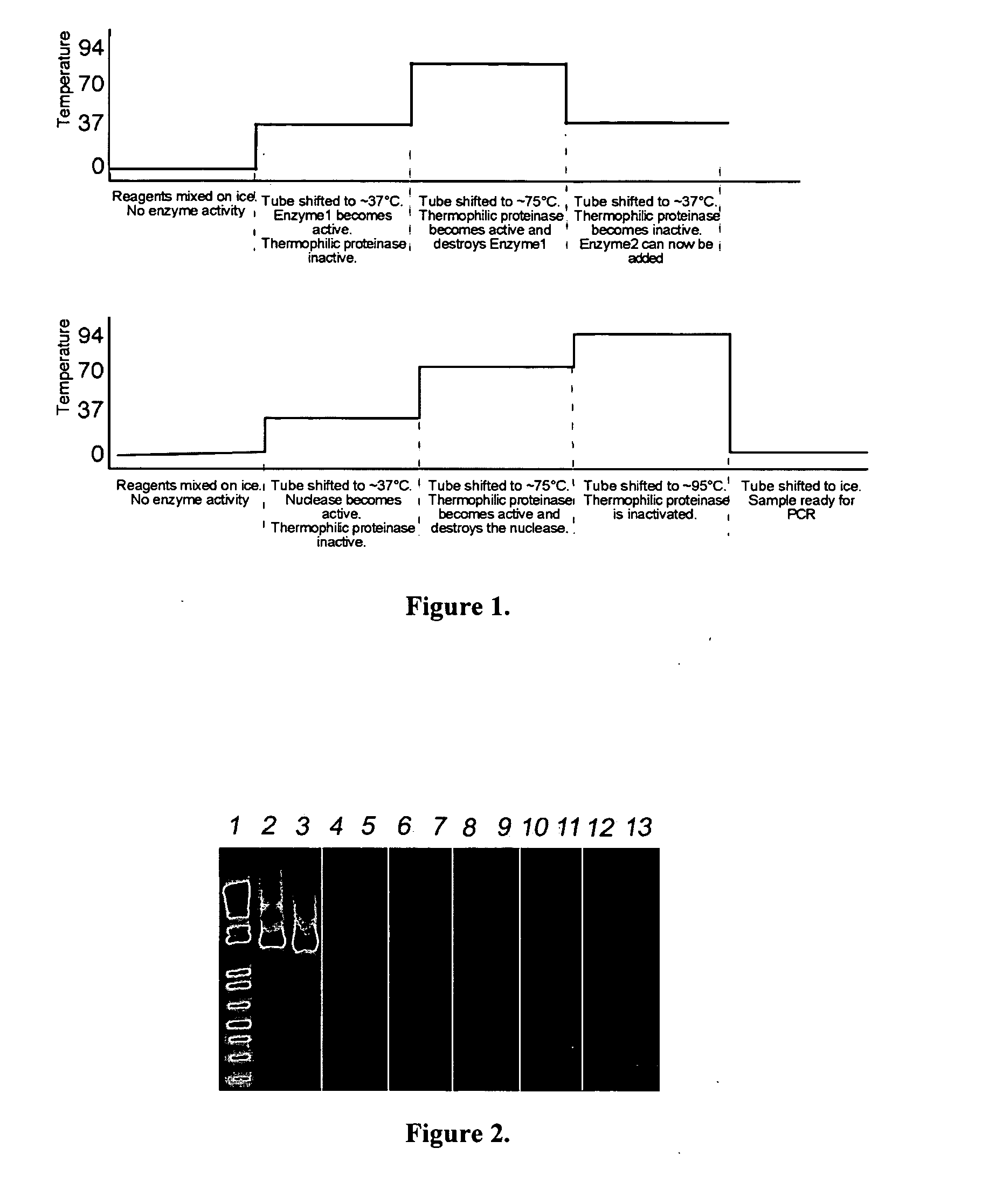Purification methods and uses thereof
a technology of purification method and purification method, which is applied in the field of improved methods for isolation, purification, diagnostic, analytical and manufacturing techniques, can solve the problems of contamination, less robust methodologies, and potentially equivocal, and achieve the effect of rapid preparation of samples
- Summary
- Abstract
- Description
- Claims
- Application Information
AI Technical Summary
Benefits of technology
Problems solved by technology
Method used
Image
Examples
example 1
Removal of DNA from Solutions
[0151] This example describes the use of cocktails of mesophilic nuclease, such as DNAse1, in conjunction with thermophilic protease to remove contaminating DNA from solutions.
[0152] Methods
[0153] PCR reagents and solutions were deliberately contaminated with a high molar quantity of target DNA (5 ng). The reagents and solutions were treated with a DNAse1 / EA1 thermophilic protease cocktail as follows: 37° C. for 15 min, 75° C. for 15 min, and 95° C. for 15 min.
[0154] To test for residual DNAse1 activity, the template and oligonucleotides were incubated at 37° C. for an additional hour. Reagents and solutions with DNAse1 added but lacking EA1 thermophilic protease were used as controls for the removal of DNAse1 activity.
[0155] Results
[0156] The combination of mesophilic nuclease and thermophilic protease was highly successful in removing DNA contamination from PCR reagents and solutions. The gel image depicted in FIG. 2 demonstrates the efficacy of ...
example 2
Removal of Contaminants from Solutions
[0160] This example describes the use of a combination of mesophilic nuclease, such as DNAse1, in conjunction with thermophilic protease to remove contamination from solutions.
[0161] Methods
[0162] Reagents and solutions were deliberately contaminated with a high molar quantity of target DNA (5 ng). The reagents and solutions were treated with a DNAse1 / EA1 thermophilic protease combination at 37° C. for 15 min, followed by 75° C. for 15 min.
[0163] To test for residual DNAse1 activity, the template and oligonucleotides were incubated at 37° C. for an additional hour. Reagents and solutions with DNAse1 added but lacking EA1 thermophilic protease were used as controls for the removal of DNAse1 activity.
[0164] Results
[0165] The combination of mesophilic nuclease and thermophilic protease was highly successful in removing contamination, both nucleic acid and added mesophilic enzyme, from reagents and solutions.
[0166] Conclusions
[0167] This met...
example 3
Removal of Heat Resistant Enzymes
[0168] This example describes the use of thermophilic protease to remove contaminating heat resistant mesophilic enzymes from solutions.
[0169] Methods
[0170] Samples of PvuII were treated as follows: control samples were subjected to no further treatment; heat treated PvuII was incubated at 75° C. for 15 min; EA1-treated PvuII was incubated at 75° C. for 15 min in the presence of EA1 thermophilic protease. These samples of PvuII was then added to aliquots of plasmid DNA and incubated. Samples were then visualised by gel electrophoresis and UV transillumination.
[0171] Results
[0172] The restriction endonuclease PvuII is resistant to heat inactivation. This is clearly shown in FIG. 5, where viable enzymatic activity is observed even after heat treatment at 75° C. for 15 min (FIG. 4, lanes 4 and 5). Incubation at 75° C. in the presence of thermophilic protease results in the complete removal of enzymatic activity (FIG. 4, lanes 6 and 7).
[0173] Concl...
PUM
| Property | Measurement | Unit |
|---|---|---|
| temperature | aaaaa | aaaaa |
| temperature | aaaaa | aaaaa |
| temperature | aaaaa | aaaaa |
Abstract
Description
Claims
Application Information
 Login to View More
Login to View More - R&D
- Intellectual Property
- Life Sciences
- Materials
- Tech Scout
- Unparalleled Data Quality
- Higher Quality Content
- 60% Fewer Hallucinations
Browse by: Latest US Patents, China's latest patents, Technical Efficacy Thesaurus, Application Domain, Technology Topic, Popular Technical Reports.
© 2025 PatSnap. All rights reserved.Legal|Privacy policy|Modern Slavery Act Transparency Statement|Sitemap|About US| Contact US: help@patsnap.com



